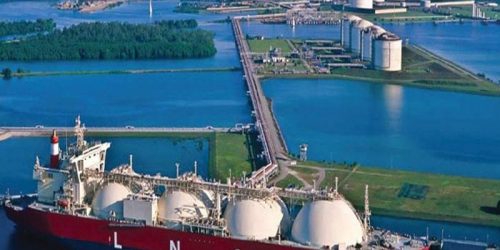The last few weeks media has been buzzing with allegations and counter-allegations about import of LNG. Both Dawn and Geo have put a figure of $200 milliom as losses due to delay in procuring LNG. Geo went further and put a figure of $122 billion losses incurred by the PTI government due to this delay and other decisions.
The debate Friday night between Former Prime Minister Shahid Khaqan Abbasi and SAPM Nadeem Babar helped clarify many issues. Babar clarified that the 23 cargos of LNG procured in the Nov/Dec/Jan window cost an average price of $6.34/mmbtu or 12.5 percent of Brent, still cheaper than the Long-term Sale Agreement (LSA) concluded with Qatar at 13.37 percent of Brent. He also informed that the 43 cargos purchased on thr spot market from 2018-to date had an average purchase price 20 percent less than the LSA with Qatar, saving the country $240 million.
Babar also addressed the other allegations namely that LNG terminal was under-utilized, stating that there was insufficient demand for LNG, and justified that the RFO oil plant, was used to generate only 3.7 percent of the power and that too due to transmission system constraints during peak hours, he also correctly pointed out what really mattered was the cost/mmbtu as that directly translates into electricity prices, regardless of percentage slope with Brent. Abbasi accused the government of delays in awarding the third LNG regasification unit and LNG pipeline.
The government was left with two main options─ imported LNG or local Thar coal (which is in abundance). Unfortunately it chose to install 3600 MW in LNG power plants, 2400MW of imported coal and one 660 MW Thar coal plant. Today the price of power from Thar coal is $55/MWh while that from imported LNG is currently $90/MWh, or almost half. Had the same “Punjab Speed and Focus” been on Thar coal, it would have saved at least $10 billion (over the 20-year project lifetime at 65 percent utilization)- this figure will increase should the rupee depreciate. In addition to reducing the country’s import bill, and foreign exchange saving of approx. $ 0.8 billion a year─ But then Tharparkar isn’t in Punjab.
NEPRA, the main electricity buyer. operates on a Merit Order System (MOS), whereby maximum power is purchased from the cheapest source and then from the second cheapest and so forth. Based on current costs, Hydel power costs are approx. $20/MWh, new renewables approx. $35, Thar coal $55, local gas and imported coal around $65, LNG power $90 and RFO plants $ 120. RFO may be the most expensive fuel but LNG is the second most expensive power source.
Today, to be able compete with Thar coal at $55/Mwh, the price of LNG at Karachi must be $3/mmbtu. Given that it costs $3 to chill and transport the gas, LNG power plants will have to have gas for free to produce power at the same cost as Thar coal plants. Today, to be able to compete with renewables at $35/MWh, the LNG price must be around $0.5/mmbtu, this would barely cover the cost of LNG transportation, let alone its costs. So anyone who takes Former Prime Minister Shahid Khaqaan Abbasi’s statement during the debate that LNG is the best source of power for Pakistan at its face value, should think again.
In the last year the price of oil increased from $30 to $50/ barrel, the price of LNG increased from $2.5 to $ 6.5/mmbtu, the price of imported thermal coal increased from $55 to $80/ton, the rupees/$ depreciated from 130 to 160. Yet due to rupee depreciation and economies of scale the price of Thar coal decreased from $55 to $40/ton. The sun and wind remained free sources of energy.
Whereas LNG was required to address the needs of existing power-plants and industrial consumers, the decision to favour LNG over domestic coal at such a large scale, was neither naïve nor ill-informed but a deliberate act of commission. Despite ample evidence, no lessons were learnt from the damage that Benazir government’s pernicious IPP policy had inflicted on the economy by relying on imported fuel─ thus exposing the customers to both foreign currency and oil price risks, not to mention the need for dollars to buy the fuel (the country still continues to pay capacity payments to expensive, idle and inefficient power plants). Despite better choices and ignoring lessons from the IPP policy, the PML(N) government deliberately chose an option that would leave economy weaker─ Why was this choice exercised? I will leave the readers to draw their own conclusions.
The energy landscape is changing. It is expected that countries with ample sunlight, such as Pakistan, to reach peak base power by 2030-35. In 10-15 years’ time, due to increasing efficiency of solar panels and battery storage cost reduction to less than $ 60/MWh, thermal generation will most probably become obsolete, with users especially in rural areas switching to renewables and disconnecting from the WAPDA grid. Is the government gearing up to this eventuality by embracing smart grids? The era of supply-side power is ending and unless the government wakes up it will be facing a glut of un-saleable power on a much larger scale than the IPP fiasco.
I would add that Friday’s was a refreshingly civilized debate. It is incumbent on the government to take the high road when addressing any allegations, and to exercise civility without resorting to unleash illiterate cyber-goons on social media. It is important for the PTI, which has prided itself on accountability, to go the extra mile to maintain a less fractious relationship with the media and to embrace criticism, particularly with the elections not that far away.







